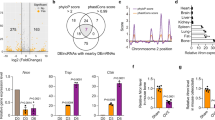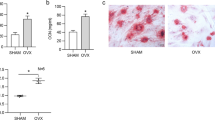Abstract
Long noncoding RNAs (lncRNAs) have emerged as integral regulators of physiology and disease, but specific roles of lncRNAs in bone disease remain largely unknown. Here, we show that lnc-ob1 regulates osteoblast activity and bone formation in mice by upregulating the osteogenic transcription factor Osterix. Expression of lnc-ob1 is enriched in osteoblasts and upregulated during osteoblastogenesis. We demonstrate that osteoblast-specific knock-in of lnc-ob1 enhances bone formation and increases bone mass. Pharmacological overexpression of lnc-ob1 specifically in osteoblasts confers resistance to ovariectomy-induced osteoporosis in mice. In humans, expression of the homologue, lnc-OB1, decreases with age in osteoblasts of patients with osteoporosis. Mechanistically, lnc-ob1 upregulates the expression of Osterix in mouse and human osteoblasts, probably via inhibition of H3K27me3 methylation. Our data indicate that lnc-OB1 regulates bone formation and might be a drug target for the treatment of osteoporosis.
This is a preview of subscription content, access via your institution
Access options
Access Nature and 54 other Nature Portfolio journals
Get Nature+, our best-value online-access subscription
$29.99 / 30 days
cancel any time
Subscribe to this journal
Receive 12 digital issues and online access to articles
$119.00 per year
only $9.92 per issue
Buy this article
- Purchase on Springer Link
- Instant access to full article PDF
Prices may be subject to local taxes which are calculated during checkout







Similar content being viewed by others
Data availability
The high-throughput RNA-seq data have been deposited in NCBI under accession code GSE112318. The data that support the findings of this study are available from the authors on reasonable request, see author contributions for specific datasets.
References
Lee, J. T. Epigenetic regulation by long noncoding RNAs. Science 338, 1435–1439 (2012).
Rinn, J. L. & Chang, H. Y. Genome regulation by long noncoding RNAs. Annu. Rev. Biochem. 81, 145–166 (2012).
Wahlestedt, C. Targeting long non-coding RNA to therapeutically upregulate gene expression. Nat. Rev. Drug Discov. 12, 433–446 (2013).
Fatica, A. & Bozzoni, I. Long non-coding RNAs: new players in cell differentiation and development. Nat. Rev. Genet. 15, 7–21 (2014).
Schmitt, A. M. & Chang, H. Y. Long noncoding RNAs in cancer pathways. Cancer Cell 29, 452–463 (2016).
Huarte, M. The emerging role of lncRNAs in cancer. Nat. Med. 21, 1253–1261 (2015).
Knoll, M., Lodish, H. F. & Sun, L. Long non-coding RNAs as regulators of the endocrine system. Nat. Rev. Endocrinol. 11, 151–160 (2015).
Sun, M. & Kraus, W. L. From discovery to function: the expanding roles of long noncoding RNAs in physiology and disease. Endocr. Rev. 36, 25–64 (2015).
Zhao, X. Y. & Lin, J. D. Long noncoding RNAs: a new regulatory code in metabolic control. Trends Biochem. Sci. 40, 586–596 (2015).
Redis, R. S. et al. Allele-specific reprogramming of cancer metabolism by the long non-coding RNA CCAT2. Mol. Cell 61, 520–534 (2016).
Atianand, M. K. & Fitzgerald, K. A. Long non-coding RNAs and control of gene expression in the immune system. Trends Mol. Med. 20, 623–631 (2014).
Ng, S. Y., Bogu, G. K., Soh, B. S. & Stanton, L. W. The long noncoding RNA RMST interacts with SOX2 to regulate neurogenesis. Mol. Cell 51, 349–359 (2013).
Ramos, A. D. et al. The long noncoding RNA Pnky regulates neuronal differentiation of embryonic and postnatal neural stem cells. Cell Stem Cell 16, 439–447 (2015).
Uchida, S. & Dimmeler, S. Long noncoding RNAs in cardiovascular diseases. Circ. Res. 116, 737–750 (2015).
Yang, L., Froberg, J. E. & Lee, J. T. Long noncoding RNAs: fresh perspectives into the RNA world. Trends Biochem. Sci. 39, 35–43 (2014).
Zhuang, W. Z. et al. Upregulation of lncRNA MEG3 promotes osteogenic differentiation of mesenchymal stem cells from multiple myeloma patients by targeting BMP4 transcription. Stem Cells 33, 1985–1997 (2015).
Huang, Y., Zheng, Y., Jia, L. & Li, W. Long noncoding RNA H19 promotes osteoblast differentiation via TGF-beta1/Smad3/HDAC signaling pathway by deriving miR-675. Stem Cells 33, 3481–3492 (2015).
Nakashima, K. et al. The novel zinc finger-containing transcription factor osterix is required for osteoblast differentiation and bone formation. Cell 108, 17–29 (2002).
Sun, Y. et al. Osteoblast-targeting-peptide modified nanoparticle for siRNA/microRNA delivery. ACS Nano 10, 5759–5768 (2016).
Margueron, R. & Reinberg, D. The polycomb complex PRC2 and its mark in life. Nature 469, 343–349 (2011).
Simon, J. A. & Kingston, R. E. Occupying chromatin: Polycomb mechanisms for getting to genomic targets, stopping transcriptional traffic, and staying put. Mol. Cell 49, 808–824 (2013).
Baron, R. & Kneissel, M. WNT signaling in bone homeostasis and disease: from human mutations to treatments. Nat. Med. 19, 179–192 (2013).
Ettinger, M. P. Aging bone and osteoporosis: strategies for preventing fractures in the elderly. Arch. Intern. Med. 163, 2237–2246 (2003).
Liu, W. et al. GDF11 decreases bone mass by stimulating osteoclastogenesis and inhibiting osteoblast differentiation. Nat. Commun. 7, 12794 (2016).
Liu, Z. et al. Mediator MED23 cooperates with RUNX2 to drive osteoblast differentiation and bone development. Nat. Commun. 7, 11149 (2016).
Zeng, H. C. et al. MicroRNA miR-23a cluster promotes osteocyte differentiation by regulating TGF-beta signalling in osteoblasts. Nat. Commun. 8, 15000 (2017).
Flynn, R. A. & Chang, H. Y. Long noncoding RNAs in cell-fate programming and reprogramming. Cell Stem Cell 14, 752–761 (2014).
Gong, C. et al. A long non-coding RNA, LncMyoD, regulates skeletal muscle differentiation by blocking IMP2-mediated mRNA translation. Dev. Cell 34, 181–191 (2015).
Thum, T. Noncoding RNAs and myocardial fibrosis. Nat. Rev. Cardiol. 11, 655–663 (2014).
Zhu, L. & Xu, P. C. Downregulated LncRNA-ANCR promotes osteoblast differentiation by targeting EZH2 and regulating Runx2 expression. Biochem. Biophys. Res. Commun. 432, 612–617 (2013).
Chang-Jun Li et al. Long noncoding RNA Bmncr regulates mesenchymal stem cell fate during skeletal aging. J. Clin. Invest. 128, 5251–5266 (2018).
Zhou, X. et al. Multiple functions of Osterix are required for bone growth and homeostasis in postnatal mice. Proc. Natl Acad. Sci. USA 20, 12919–12924 (2010).
Nakashima, K. & de Crombrugghe, B. Transcriptional mechanisms in osteoblast differentiation and bone formation. Trends Genet. 19, 458–466 (2003).
Long, F. Building strong bones: molecular regulation of the osteoblast lineage. Rev. Mol. Cell Biol. 13, 27–38 (2011).
Koga, T. et al. NFAT and Osterix cooperatively regulate bone formation. Nat. Med. 11, 880–885 (2005).
Hojo, H., Ohba, S., He, X. J., Lai, L. P. & McMahon, A. P. Sp7/Osterix is restricted to bone-forming vertebrates where It acts as a Dlx co-factor in osteoblast specification. Dev. Cell 37, 238–253 (2016).
Crandall, C. Parathyroid hormone for treatment of osteoporosis. Arch. Intern. Med. 162, 2297–2309 (2002).
Canalis, E. New treatment modalities in osteoporosis. Endocr. Pract. 16, 855–863 (2010).
Nikitovic, D. et al. Parathyroid hormone/parathyroid hormone-related peptide regulate osteosarcoma cell functions: focus on the extracellular matrix. Oncol. Rep. 36, 1787–1792 (2016).
Cheloha, R. W., Gellman, S. H., Vilardaga, J. P. & Gardella, T. J. PTH receptor-1 signalling-mechanistic insights and therapeutic prospects. Nat. Rev. Endocrinol. 11, 712–724 (2015).
Morlan, J. D., Qu, K. & Sinicropi, D. V. Selective depletion of rRNA enables whole transcriptome profiling of archival fixed tissue. PLoS ONE 7, e42882 (2012).
Necsulea, A. et al. The evolution of lncRNA repertoires and expression patterns in tetrapods. Nature 505, 635–640 (2014).
Acknowledgements
This research was supported by grants from the National key research and development program (2016YFC102705/2017YFA0505001/2018YFC0910200); National Natural Science Foundation Projects (No. 81822012, 81771043, 81770873, 81722031, 81470715, 81771043, 31671312, 3137134); 2017BR009, 2014BAI04B07 and Kx0200020173386, Guangdong Natural Science Funds (no. 2014A030313358), the Major Project in Guangdong Province of Science (no. 2014KZDXM011) and Guangdong Natural Science Funds for Distinguished Young Scholars (no. S2013050013880). We thank C. Qin for providing the DMP1 antibody as a gift. We thank Y. Zhang and S. Gao at Tongji University for providing critical comments and technical support. We thank J. Li for help with the style of the manuscript.
Author information
Authors and Affiliations
Contributions
X.W. and Y.S. conceived and designed the project and wrote the manuscript with input from M.C., L.Y., J.Z., H.L., Y.Z., F.J., D.J. and X.L. M.C. performed the histological experiments. J.Z. performed the RNA-seq experiments and analysed the data. L.Y., F.J. and J.X. performed the cellular experiments. H.X. contributed the fracture model in the revised version. H.L., Y.Z., X.J., A.H., Z.W. and G.Z. analysed data and provided important suggestions regarding this project.
Corresponding authors
Ethics declarations
Competing interests
The authors declare no competing interests.
Additional information
Publisher’s note: Springer Nature remains neutral with regard to jurisdictional claims in published maps and institutional affiliations.
Supplementary information
Supplementary Information
Supplementary Figures 1–18 and Supplementary Tables 1–4
Rights and permissions
About this article
Cite this article
Sun, Y., Cai, M., Zhong, J. et al. The long noncoding RNA lnc-ob1 facilitates bone formation by upregulating Osterix in osteoblasts. Nat Metab 1, 485–496 (2019). https://doi.org/10.1038/s42255-019-0053-8
Received:
Accepted:
Published:
Issue Date:
DOI: https://doi.org/10.1038/s42255-019-0053-8
This article is cited by
-
A DNA tetrahedron-based ferroptosis-suppressing nanoparticle: superior delivery of curcumin and alleviation of diabetic osteoporosis
Bone Research (2024)
-
Long noncoding RNA Malat1 protects against osteoporosis and bone metastasis
Nature Communications (2024)
-
Emerging nano-scale delivery systems for the treatment of osteoporosis
Biomaterials Research (2023)
-
Bone marrow mesenchymal stem cell-derived exosomal microRNA-382 promotes osteogenesis in osteoblast via regulation of SLIT2
Journal of Orthopaedic Surgery and Research (2023)
-
RNA-based nanomedicines and their clinical applications
Nano Research (2023)



